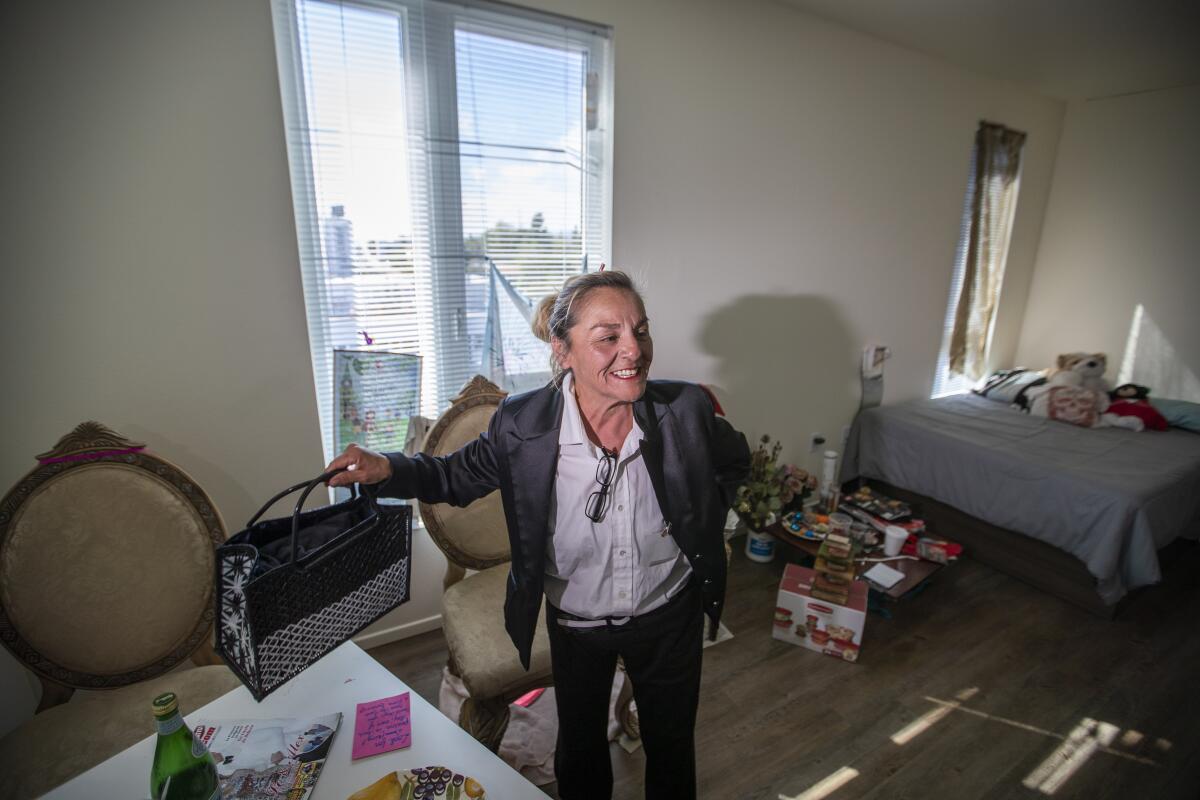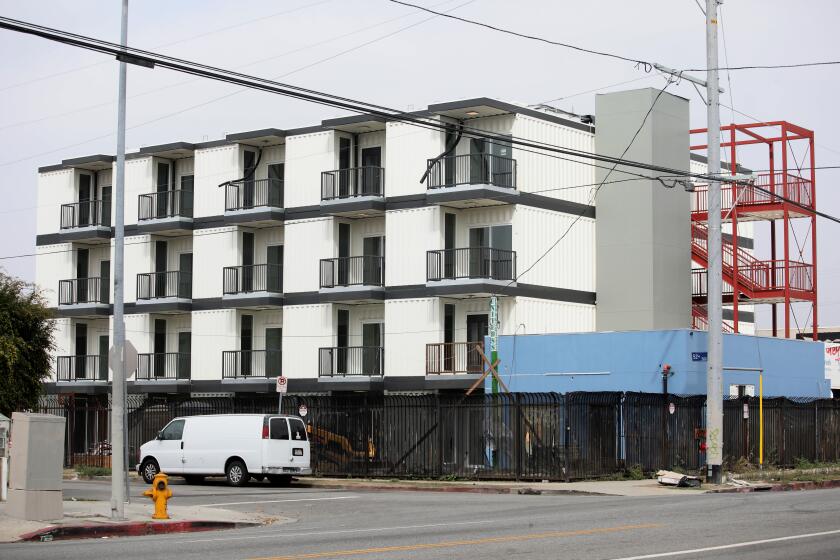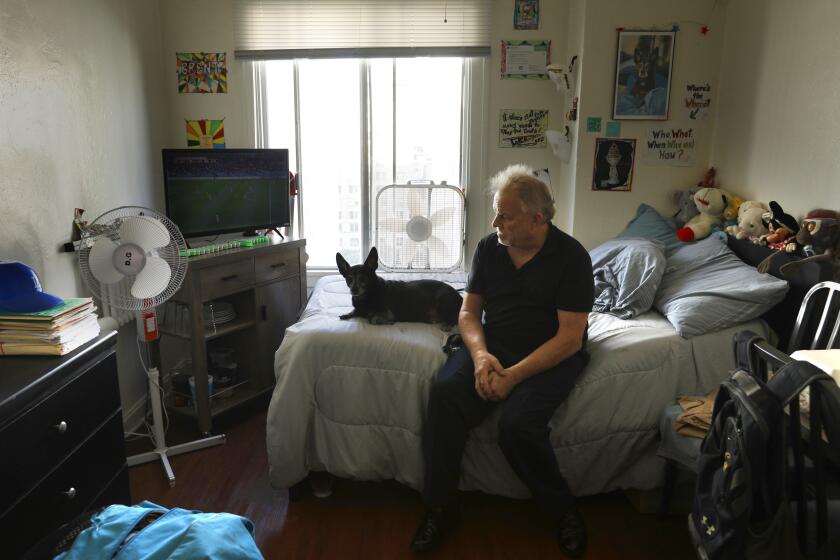Editorial: Homeless people shouldn’t spend weeks proving they’re poor before they get an apartment

- Share via
From Venice to downtown Los Angeles, Mayor Karen Bass’ Inside Safe program moved some 1,200 homeless people out of encampments into motels and hotels during her first four months in office. But only 70 people have moved from those temporary accommodations into permanent housing, Bass said recently. That’s a number she rightly finds disappointing.
Of course, it’s not entirely surprising; Los Angeles has a crippling shortage of housing for homeless people and affordable housing in general. But the pace at which Inside Safe participants — or any homeless person eligible for a rent voucher — are housed should pick up when, as the mayor said, “we have hundreds of vacancies in permanent supportive housing.”
New permanent supportive-housing developments are generally not sitting half-empty. Developers know when a property will open. Service providers and homeless services officials can start lining up prospective tenants in advance. The vacancies Bass is talking about are created, mostly, when tenants in permanent supportive housing leave their unit or die. But some of those empty units stay empty for quite awhile, according to developers and city housing officials.
Pouring money into trying to solve homelessness without also making it much easier, faster and cheaper to build housing, especially affordable housing, is a fool’s errand.
Why? Because even when a homeless person is deemed eligible for a rent voucher connected to an available housing unit, it can take weeks and sometimes a few months for the prospective tenant to obtain the necessary documents to be approved for the voucher and the unit.
Homeless applicants need a driver’s license or other government-issued identification, a Social Security card, proof of their income (usually a very small amount from county-funded General Relief or a larger amount from Supplemental Security Income for people who are disabled or older), a form filled out by a case manager certifying that they are homeless, proof of citizenship or legal residency in the U.S., and a criminal background check. All of these items are time-consuming to collect. Many homeless individuals need the help of a case manager to take them to government offices and help them fill out applications for these documents, which can take hours at a time.
Then, once they have their documentation in order, they need to fill out an application to the Housing Authority of the City of Los Angeles for the available unit. Then the unit needs to be inspected. Those processes add to the wait time as well.
Yes, people can start trying to get their documents before anyone ever tells them there’s an available apartment. In fact, they may have started, helped by an outreach worker, when they were living in a tent. Sometimes a homeless person gets all the documents before being considered for permanent housing, but those materials can be lost during the wait.
A year after opening 600 rooms to L.A.’s unhoused, the Cecil Hotel is still mostly empty. Here’s why
The Cecil Hotel was supposed to be an innovative new model for permanent supportive housing in L.A. Why is it struggling to fill rooms?
“Imagine going from encampment to encampment carrying your birth certificate and Social Security card in a Ziploc bag and hoping they don’t get stolen,” one service provider said. Or the documents get thrown away by sanitation workers during a sidewalk cleanup. Or damaged by a fire. All these things have happened to homeless people, which means they have to start over.
Maybe a homeless individual was able to get these documents together a few months before they were matched to an apartment. But by the time an apartment becomes ready, some of the documents — for income certification and homelessness status — expire after 60 days, and some people may have to start the process over again.
This is absurd. It’s bad enough that Los Angeles doesn’t have enough apartments for homeless people. But when the city does have available apartments, they sit empty while people document their existence?
Most of this documentation is required by the U.S. Department of Housing and Urban Development for people getting federally subsidized rental vouchers. So Bass has written to HUD officials asking them to expedite the leasing process by giving these would-be voucher holders “presumptive eligibility.” Her request supports a letter already submitted by the Housing Authority of the City of Los Angeles and the Los Angeles County Development Authority.
“Why do we have to spend weeks and weeks and weeks trying to get IDs and having somebody prove that they’re poor?” Bass said.
If HUD officials sign off on her request, homeless people would be able to “self-certify” their income and submit documentation within four months of getting the housing voucher. Similarly, they could provide proof of their Social Security numbers, date of birth and citizenship status after they are in the housing.
All this makes sense. We want homeless people to get permanent housing as soon as possible. And it’s easier to collect or update personal records when a person is in a stable home. Some of these requirements were waived during the pandemic, and service providers found that the leasing process went faster.
Last week, Los Angeles, the state of California and four other regions were selected by the White House and the U.S. Interagency Council on Homelessness to be part of an initiative called ALL INside, which is intended to support and speed up efforts to house homeless people. The first thing the federal government can do is stop making homeless people run an obstacle course before they get to move into apartments that are available.
More to Read
A cure for the common opinion
Get thought-provoking perspectives with our weekly newsletter.
You may occasionally receive promotional content from the Los Angeles Times.












